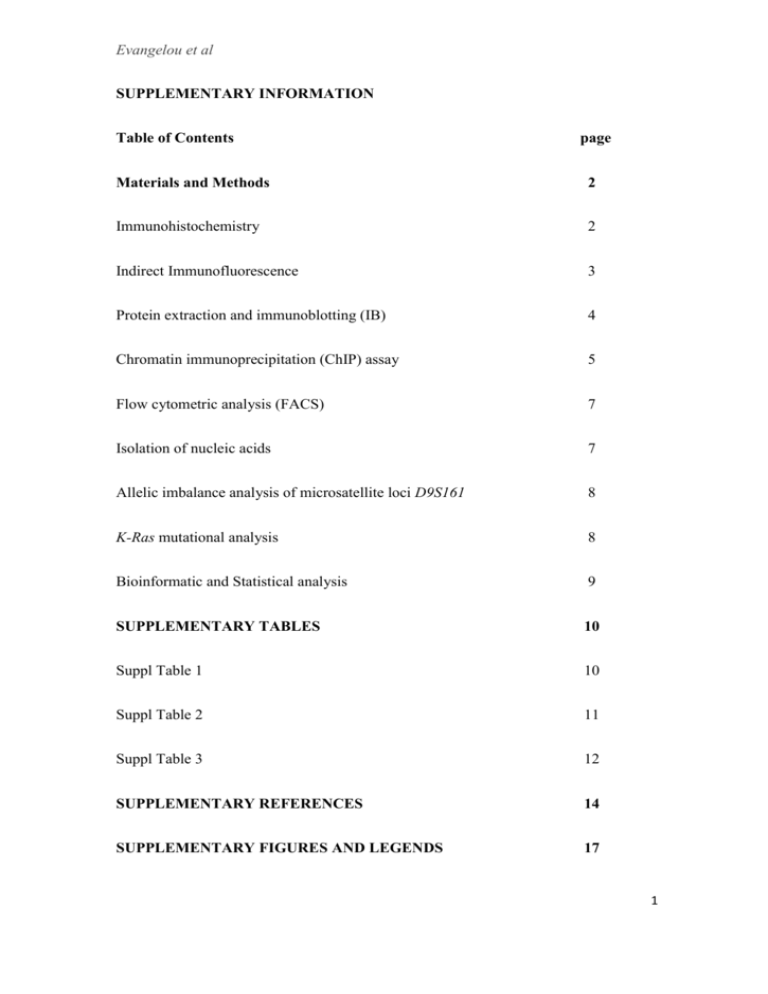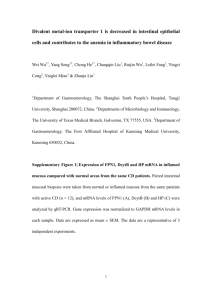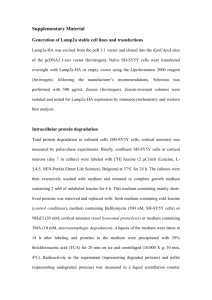Supplementary Information (doc 75K)
advertisement

Evangelou et al SUPPLEMENTARY INFORMATION Table of Contents page Materials and Methods 2 Immunohistochemistry 2 Indirect Immunofluorescence 3 Protein extraction and immunoblotting (IB) 4 Chromatin immunoprecipitation (ChIP) assay 5 Flow cytometric analysis (FACS) 7 Isolation of nucleic acids 7 Allelic imbalance analysis of microsatellite loci D9S161 8 K-Ras mutational analysis 8 Bioinformatic and Statistical analysis 9 SUPPLEMENTARY TABLES 10 Suppl Table 1 10 Suppl Table 2 11 Suppl Table 3 12 SUPPLEMENTARY REFERENCES 14 SUPPLEMENTARY FIGURES AND LEGENDS 17 1 Evangelou et al Materials and Methods Immunohistochemistry (IHC) The following antibodies were used: anti-p14ARF (1:100) (ab49166, Abcam), antip14ARF (1:100) (4C6/4, Cell Signaling), anti-p14ARF (1:500) (rabbit, Ab4, NeoMarkers), anti-phospho-histone H2A.X (1:1000) (Ser139, 05-636, Millipore), antiATM-pS1981 (1:100) (sc47739, Santa Cruz,), anti-ATM-p (1:100) (mouse monoclonal),7 anti-Chk2-pT68 (IHC 1:100) (NB100-92502, Novus Biologicals), antip53 (1:100) (DO-7, sc47698, Santa Cruz,), anti-p53 (1:100) (DO-1, sc-126, Santa Cruz), anti-p53 (1:400) (CM5p, Novocastra), anti-p21WAF1 (IHC 1:200) (F-5, sc6246Santa Cruz,), anti-p16INK4A (IHC 1:100) (F-12, sc1661, Santa Cruz), anti- p19ARF (1:100) (M-60, sc22784, Santa Cruz). Immunohistochemistry was performed using the UltraVision LP Detection System (#TL-060-HD, Thermo Scientific, Bioanalytica, Greece) according to the manufacturer’s instructions. Thin paraffin sections (4 μm) were deparaffinised in xylene and rehydrated in a graded series of ethanol-aqueous solutions. Antigen retrieval was carried out in 10mM citrate buffer (pH 6.0) by heating the slides for 25 min in a microwave oven. Endogenous peroxidase activity was blocked by incubating the sections in 3% hydrogen peroxide in TBS for 10 min. The primary antibodies were incubated overnight. For p21WAF1, p16INK4A, p14ARF a Labeling Index (LI) was established, based on the proportion of positive nuclei since staining intensity was strong. Evaluation and controls for γΗ2ΑΧ, Chk2-pT68, ATM-p, ATM and p53 have been previously described.7-9 2 Evangelou et al For immunohistochemistry of human urinary bladder tissues and tumours, the tissue sections were deparaffinized and processed for sensitive immunoperoxidase staining with the primary antibodies against the individual markers, as follows: The primary antibodies were incubated overnight, followed by detection using the Vectastain Elite kit (Vector Laboratories, Burlingame, CA, USA) and nickel sulphate enhancement without nuclear counterstaining.7,9 Immunostaining patterns on each slide were scored as reported previously,7,9 and the threshold for scoring as enhanced expression was as indicated above. Indirect Immunofluorescence (IF) Indirect IF analysis was performed according to a published protocol.11 Briefly, cells cultured on coverslips were fixed in 4% formaldehyde and permeabilized by 0.1% Triton X-100 in two consecutive steps, each for 15 minutes at RT. After washing with PBS, cells were blocked for 30 minutes in 10% foetal calf serum. The following primary antibodies were used: mouse monoclonal antibody against histone H2A.X phosphorylated at serine 139 (γH2AX; Abcam, ab22551, 1:500), mouse monoclonal antibody against Cytochrome c (BD Pharmingen, 556432, 1:100), rabbit 53BP1 (Santa Cruz, sc-22760, 1:1000), anti-E2F1 antibody (Santa Cruz, sc-251, 1:1000). Incubation with primary antibodies was performed for 60 minutes at RT and then cells were washed with PBS. Secondary antibodies Alexa Fluor® 488 goat anti-rabbit (Invitrogen, #A11034, 1:500) and Alexa Fluor® 568 goat anti-mouse (Invitrogen, #A110-31, 1:500) were then applied for 60 minutes at RT, followed by final wash in PBS. Coverslips were mounted in Vectashield Mounting Medium with 100 ng/ml of 4,6-diamidino-2-phenylindole (DAPI) (Vector Laboratories, #H-1200). Image 3 Evangelou et al acquisition of multiple random fields was automated on a Scan^R screening station (Olympus, Germany) and analyzed by using Scan^R (Olympus, Germany) analysis software, or a Zeiss Axiolab fluorescence microscope equipped with a Zeiss Axiocam MRm camera and Achroplan objectives while image acquisition was performed with AxioVision software release 4.7.1. Protein extraction and immunoblotting (IB) The following antibodies were applied: anti-p14ARF (1:100) (Abcam), anti-ATM (1:500) (Millipore), anti-γH2AX (1:500) (Millipore), anti-H2AX (1:500) (Millipore), anti-Chk2-pT68 (1:100) (Novus Biologicals), anti-p53 (1:100) (Santa Cruz), antip21WAF1 (1:200) (Novocastra), anti-p16INK4A (IHC 1:100) (Santa Cruz), anti-p19ARF (1:100) (Santa Cruz), anti-β-catenin (1:500) (Santa Cruz), anti-Ha-Ras (1:100) (Santa Cruz), anti-β-actin (1:1000) (Cell Signaling Tech), anti-alpha-tubulin (1:10,000) (Sigma), anti-CDK7 (1:1000) (Abcam). Treated cells were lysed and protein lysates were subjected to IB analyses as previously described.11 Briefly, cells were homogenized in 50 mmol/L HEPES, pH 7.5, 150 mmol/L NaCl, 15 mmol/L ß-mercaptoethanol, 0.5 mmol/L phenylmethanesulfonyl fluoride (PMSF), 0.1% Nonidet P-40 (Sigma) and the solution was centrifuged at 12500 rpm (1000 x g) at 4°C for 10 minutes. The supernatant was isolated and adjusted to 1μg/ml protease and phosphatase inhibitors (Pierce). The pellet was diluted in 10mM HEPES pH 7.9, 1.5mM MgCl2, 10mM KCl, 0.5mM DTT, and 1.5mM PMSF, incubated in ice for 30 min and centrifuged at 12500 rpm (1000 x g) at 4°C for 10 minutes. Total protein concentration was estimated using the Bio-Rad Protein Assay 4 Evangelou et al (Bio-Rad). 30 μg of protein extracts were adjusted with Laemmli Buffer (Sigma) and loaded on SDS poly-acrylamide/bis-acrylamide gels (PAGE). Gel electrophoresis and transfer to PVDF membrane (Millipore) were carried out according to standard methods. Blots were incubated for 1h in 5% non-fat milk in TBS-0.1% (v/v) Tween-20 solution at room temperature. Primary antibody solution in 0.5% non-fat milk in TBS supplemented with 0.1 % (v/v) Tween-20 at room temperature was applied on membranes overninght, followed by a 45 min incubation with the appropriate alkaline phosphatase conjugated secondary antibody (1:5,000 dilution) (Promega) at room temperature. Signal visualization was carried out with application in nitro blue tetrazolium/5-bromo-4-chloro-3-indolylphosphate (NBT/BCIP) solution (Molecular Probes). Chromatin immunoprecipitation (ChIP) assay ChIP assays were performed as previously described.S71 3×106 normal HBECs transiently transduced with the pBabe-Ha-RasV12 or transfected with anti-p53 siRNA, 3×106 immortalized (hTERT/Cdk4) HBECs and immortalized HBECs transfected with K-RasV12, respectively, were crosslinked with 1% formaldehyde for 10 min at 37oC. Crosslinking was stopped by addition of glycine to a final concentration of 125 mM for 5 min at 37oC. Cross-linked cells were washed twice in ice-cold PBS and scraped in 1 ml PBS containing protease and phosphatase inhibitors. Cells were collected by centrifugation for 5 min, 2,000 rpm and the pellet was resuspended in 600 μl of buffer (50 mM Tris-HCl pH 8.0, 85 mM KCl and 0.5% NP40) and incubated for 10 min on ice. The lysate was centrifuged for 5 min at 5,000 rpm and the pellet resuspended in 5 Evangelou et al 600 μl of lysis buffer (50 mM Hepes-KOH pH 7.5, 150 mM NaCl, 1 mM EDTA pH 8.0, 1% Triton-X, 0.1% Sodium Deoxycholate and 0.1% SDS) containing protease and phosphatase inhibitors. Lysates were sonicated to shear DNA to an average fragment size of 500 – 1,000 bp. The debris was pelleted by 5 min centrifugation at 13,000 rpm at 4oC and the soluble chromatin material was precleared with salmon sperm DNA/50% protein A agarose slurry (Millipore). An anti-E2F1 antibody (sc-251 X, Santa Cruz) was used for the immunoprecipitation. After overnight incubation the immune complexes were harvested with 60 μl salmon sperm DNA/50% protein A agarose slurry (Millipore) for 2 h at 4oC. The beads were washed sequentially for 5 min each at room temperature in 1 ml lysis buffer without SDS, in 1 ml lysis buffer plus 500 mM NaCl, in 1 ml buffer (10 mM Tris-HCl pH 8.0, 1 mM EDTA pH 8.0, 250 mM LiCl, 1% NP40, 1% sodium deoxycholate) and finally twice in TE. Immune complexes were eluted with 200 μl (2 times of 100 μl each) elution buffer (1% SDS, 50 mM Tris-HCl pH 7.5, 10 mM EDTA) and incubated for 5 min at 65 oC. The pooled eluates were incubated with RNAse for 1 h and 4 h with proteinase K at 65 oC. DNA was extracted by phenol-chlorophorm and precipitated with 10 μg glycogen and ethanol overnight at -20oC. The DNA was resuspended in 10 μl TE. DNA from the precipitated complexes was amplified by real-time PCR in a DNA-Engine-Opticon (MJ-Research) cycler employing the Platinum SYBR Green qPCR SuperMix-UDG (Invitrogen). A 310 bp fragment encompassing the human p14ARF promoter and a 5’distantly located (650bp) fragment of 210 bp representing a negative control (NC) for E2F1 binding, were amplified with primers (and annealing temperatures) provided in Suppl Table 3. As inputs we used products that corresponded to PCR reactions containing 1% of the total chromatin extract used in the immunoprecipitation reactions. 6 Evangelou et al Flow cytometric analysis (FACS) FACS analysis was conducted as previously described.11 HBECs were initially infected with retroviruses containing pBabe-Ha-RasV12 and pBabe, supplemented with 10 μg/ml polybrene (Sigma), as previously described.11 After 24 hours cells were transfected with control siRNA, anti-ATM siRNA, anti-ARF siRNA or anti-p53 siRNA, as previously described (Figure 3).11 After the next 2 days, cells from each treatment were harvested with trypsinization and centrifuged at 1,000 rpm for 5 min at room temperature. The pellet was resuspended in 500 μl PBS, fixed with 80% ethanol, vortexed and stained with propidium iodide (50 μg/ml), in the presence of 5 mM MgCl2 and 10 μg/ml RNAse A in 10 mM Tris–HCl pH 7.5. DNA content was assessed on a FACS Calibur (Becton-Dickinson). Data from three independent measurements were averaged and corresponding s.d. is also reported. Isolation of nucleic acids DNA extraction: cells were lysed in 50 mM Tris-HCl (pH 8.0), 150 mM NaCl, 5 mM EDTA, 1% SDS in the presence of proteinase K (0.1 mg/ml) until completely dissolved. DNA was extracted with phenol/chloroform and RNase (Sigma) digestion, followed by ethanol precipitation.11 RNA isolation with the Trizol reagent (Invitrogen) was employed following the manufacturer’s instructions and has been previously described.11 Quality and quantity of isolated nucleic acids was estimated by spectrophotometry, fluorometry and gel electrophoresis. 7 Evangelou et al Allelic imbalance analysis of microsatellite loci D9S161 The D9S161 marker located within the chromosome locus 9p21-23, was examined and LOH analysis was performed as previously described.S72 In brief, PCR reactions were carried out using previous published primers and conditions.S72 PCR products were electrophoretically separated on 10% polyacrylamide gels and stained with silver nitrate. They were then analyzed by capillary chip electrophoresis on a 2100 Bioanalyser (Agilent). LOH was determined by densitometry, comparing the allelic ratio of the normal against that of the cancerous tissue, as previously detailed described.S72 A reduction of one of the alleles in the carcinomas was considered to represent LOH. Alterations were confirmed by performing independent duplicate reactions. K-Ras mutational analysis K-Ras mutation status at codons 12 and 13 was established by using PCR-RFLP combined with Sanger sequencing. Briefly, duplicate semi-nested PCR reactions per each sample were set up, as previously published.S73 Products from each duplicate, were in turn employed in a RFLP reaction and a Sanger cycle sequencing reaction. For assessment of K-Ras mutation status at codons 12 and 13 by RFLP, the semi-nested amplified products were subjected to BstXI and XcmI digestion, correspondingly, as previously described.S73 RFLP products were analyzed on 10% polyacrylamide gels along with corresponding positive and negative codon 12 and 13 controls. Sanger sequencing was performed on a 377 ABI PRISM sequencer following the 8 Evangelou et al manufacturer’s instructions. Cases that failed to give same results in the duplicates and by both approaches were subjected to re-evaluation. Bioinformatic and Statistical analysis Data from SNP arrays were analyzed with the R package, Rseg.S74 For other statistical analyses, ANOVA and Mann-Whitney tests were used by employing the SPSS 17.0 software. 9 Evangelou et al SUPPLEMENTARY TABLES Suppl. Table 1. Analysis of DDR markers (protein) and CDKN2A locus genes p14ARF and p16INK4A (at both protein, n=110; and mRNA, n=40, levels) in human tissues from urinary bladder tumours (Ta, T1 and T2-4 lesions) and normal urothelium (percentage of cases with positive expression)* and frequency of genomic losses at CDKN2A locus compared to the stage of tumour. Total number of tumours showing losses was 23 tumours derived from 14 patients. 22 Tumours from 17 patients showed no losses. Marker Normal Ta T1 T2-T4 p14ARF 0 0 12 27 p14ARF mRNA 0 4 11 63 pATM (DDR) 0 90 90 75 p16INK4A 0 60 31 70 p16INK4A mRNA 0 20 33 33 CDKN2A locus deletion 0 50 56 50 . * positive expression for protein markers indicates percentage of cases in which 10% or more tumour cells scored positive; for mRNA levels positive cases are those with at least two-fold higher expression compared to normal level. mRNA expression was examined in only a subset (n=33) among the 103 lesions examined by immunohistochemistry. 10 Evangelou et al Suppl. Table 2. Fold of change of p14ARF and p16INK4A mRNA expression levels between normal bladder epithelium and cancerous samples as well as between Ta and cancerous lesions Normal vs cancer Normal vs Ta Ta vs cancer p14ARF fold change* p-value** 0.5 0.02 0.3 0.11 0.4 0.001 p16INK4A fold change* p-value** 0.8 0.0006 0.7 0.006 0.04 0.3 *log2 fold change values ** t-test statistics 11 Evangelou et al Suppl. Table 3. Primers and annealing temperatures in the real-time RT-PCR analyses Primer sequence Annealing temp Application p14ARF: (Fw1) 5΄-ATGGTGCGCAGGTTCTTGGTGA-3΄ (Rv1) 5΄-GGGGTCGGCGCAGTTGGGCTCA-3΄ 60°C mRNA analysisS77 (Fw2) 5´-CCCTCGTGCTGATGCTACTGA-3´ (Rv2) 5´- CATGACCTGGTCTTCTAGGAAGC-3´ 60°C mRNA analysisS78 (Fw3) 5´- CTACTGAGGAGCCAGCGTCTA-3´ (Rv3) 5´-CTGCCCATCATCATGACCT-3´ 60°C mRNA analysis (Rv1) 5´-CACGGGTCGGGTGAGAGT-3´ 60°C mRNA analysis (Fw2) 5’-CTGCCCAACGCACCGA-3´ (Rv2) 5’-CCATCATCATGACCTGGATCG-3´ 60°C mRNA analysisS78 (Fw3) 5´- GAGCAGCATGGAGCCTTC-3´ (Rv3) 5´-CTGCCCATCATCATGACCT-3´ 60°C mRNA analysis 60°C mRNA analysis 50°C mRNA analysis 58°C mRNA analysis p16INK4A: (Fw1) 5´-CCAACGCACCGAATAGTTAC-3´ Noxa: (Fw) 5’-GCTGGAAGTCGAGTGTGCTA-3’ (Rv) 5’-CCTGAGCAGAAGAGTTTGGA-3’ Puma: (Fw) 5’-GACCTCAACGCACAGTA-3’ (Rv) 5’-CTAATTGGGCTCCATCT-3’ Bax: (Fw) 5’-TGCTTCAGGGTTTCATCCAG-3’ (Rv) 5’-GGCGGCAATCATCCTCTG-3’ 12 Evangelou et al PBGD: (Fw) 5’- TGCAACGGCGGAAGAAAACA-3’ (Rv) 5’-GCAGATGGCTCCGATGGTG-3’ 50-60°C mRNA analysis 50-60°C mRNA analysis 60°C mRNA analysis 60°C mRNA analysis 60°C ChIP analysis 60°C ChIP analysis GAPDH: (Fw) 5´-AGCCACATCGCTCAGACAC-3` (Rv) 5´- GCCCAATACGACCAAATCC -3´ p21WAF1: (Fw) 5´-TCACTGTCTTGTACCCTTGTGC-3´ (Rv) 5´- GGCGTTTGGAGTGGTAGAAA-3´ p53: (Fw) 5´- CCCCAGCCAAAGAAGAAAC-3´ (Rv) 5´- AACATCTCGAAGCGCTCAC-3´ Promoter p14ARF: (Fw) 5’-TGAGGGTGGGAAGATGGTG-3’ (Rv) 5’- CCCCTTAACTGCAGACTGG -3’ Negative control promoter p14ARF: (Fw) 5’-GGACATGGAGGGGGAGACC-3’ (Rv) 5’- CTTCTTCCTCTTTCCTCTTCC -3’ . 13 Evangelou et al Suppl. References S61. Zhang ZT, Pak J, Huang HY, Shapiro E, Sun TT, Pellicer A, et al. Role of Ha-ras activation in superficial papillary pathway of urothelial tumor formation. Oncogene 2001; 20: 1973-1980 S62. Hingorani SR, Petricoin EF, Maitra A, Rajapakse V, King C, Jacobetz MA, et al. Preinvasive and invasive ductal pancreatic cancer and its early detection in the mouse. Cancer Cell 2003; 4: 437-450 S63. Tuveson DA, Hingorani SR. Ductal pancreatic cancer in humans and mice. Cold Spring Harb Symp Quant Biol 2005; 70: 65-72 S64. Klinakis A, Lobry C, Abdel-Wahab O, Oh P, Haeno H, Buonamici S, et al. A novel tumour-suppressor function for the Notch pathway in myeloid leukaemia. Nature 2011; 473: 230-233 S65. de Luca C, Kowalski TJ, Zhang Y, Elmquist JK, Lee C, Kilimann MW, et al. Complete rescue of obesity, diabetes, and infertility in db/db mice by neuron-specific LEPR-B transgenes. J Clin Invest 2005; 115: 3484-93 S66. Liontos M, Niforou K, Velimezi G, Vougas K, Evangelou K, Apostolopoulou K, et al. Modulation of the E2F1-driven cancer cell fate by the DNA damage response machinery and potential novel E2F1 targets in osteosarcomas. Am J Pathol 2009; 175: 376-391 S67. Hickson I, Zhao Y, Richardson CJ, Green SJ, Martin NM, Orr AI, et al. Identification and Characterization of a Novel and Specific Inhibitor of the AtaxiaTelangiectasia Mutated Kinase ATM. Cancer Res 2004; 64: 9152-9159 14 Evangelou et al S68. Tiscornia G, Singer O, Verma IM. Production and purification of lentiviral vectors. Nat Protoc 2006; 1: 241-245 S69. Godar S, Ince TA, Bell GW, Feldser D, Donaher JL, Bergh J, et al. Growthinhibitory and tumor- suppressive functions of p53 depend on its repression of CD44 expression. Cell 2008; 134: 62-73 S70. Damalas A, Ben-Ze'ev A, Simcha I, Shtutman M, Leal JF, Zhurinsky J, et al. Excess beta-catenin promotes accumulation of transcriptionally active p53. EMBO J. 1999; 18: 3054-63. S71. Sideridou M, Zakopoulou R, Evangelou K, Liontos M, Kotsinas A, Rampakakis E, et al. Cdc6 expression represses E-cadherin transcription and activates adjacent replication origins. J Cell Biol 2011; 195: 1123-1140 S72. Mariatos G, Gorgoulis VG, Zacharatos P, Kotsinas A, Vogiatzi T, Rassidakis G, et al. Expression of p16(INK4A) and alterations of the 9p21-23 chromosome region in non-small-cell lung carcinomas: relationship with tumor growth parameters and ploidy status. Int J Cancer 2000; 89: 133-141 S73. Dijkstra JR, Opdam FJ, Boonyaratanakornkit J, Schönbrunner ER, Shahbazian M, Edsjö A, et al. Implementation of formalin-fixed, paraffin-embedded cell line pellets as high-quality process controls in quality assessment programs for KRAS mutation analysis. J Mol Diagn 2012; 14: 187-191 S74. Lamy P, Wiuf C, Ørntoft TF, Andersen CL. Rseg--an R package to optimize segmentation of SNP array data. Bioinformatics 2011; 27: 419-420 15 Evangelou et al S75. Akiyama Y. "TFSEARCH: Searching Transcription Factor Binding Sites", 1995; http://www.rwcp.or.jp/papia/ S76. Heinemeyer T, Wingender E, Reuter I, Hermjakob H, Kel AE, Kel OV, et al. Databases on Transcriptional Regulation: TRANSFAC, TRRD, and COMPEL. Nucleic Acids Res 1998; 26: 364-370 S77. Pollice A, Nasti V, Ronca R, Vivo M, Lo Iacono M, Calogero R, et al. Functional and physical interaction of the human ARF tumor suppressor with Tat-binding protein1. J Biol Chem 2004; 279: 6345-6353 S78. Michaloglou C, Vredeveld LC, Soengas MS, Denoyelle C, Kuilman T, van der Horst CM, et al. BRAFE600-associated senescence-like cell cycle arrest of human naevi. Nature 2005; 436: 720-724 16 Evangelou et al Suppl. Figure Legends Suppl. Figure 1. a. The DNA Damage Response (DDR) is activated earlier than ARF during murine pancreatic carcinogenesis from PanIN-1, whereas ARF is upregulated in PanIN2-3. Insets depict areas of higher magnification. b. The DDR activation precedes ARF expression in an Ncst-/- mouse skin model. Insets depict areas of higher magnification Scale =50 μm. Suppl. Figure 2. Representative immunohistochemical results of ARF expression, assessed with two different anti-p14ARF antibodies in serial sections obtained from a set of five human Head and Neck carcinoma cases comprising the whole spectrum of precancerous and cancerous lesions, located in adjacent regions within the same section and mounted on the same slide. The absence/low immunohistochemical expression of ARF in normal, hyperplastic and dysplastic epithelium in adjacent regions and its elevated immunolabeling in the carcinoma located near the corresponding precancerous lesions were observed with both antibodies. This indicates rather low ARF protein expression in the early stages rather than high working thresholds of both ARF antibodies. Scale =50 μm. Suppl. Figure 3. Affymetrix Exon Array 1.0 probeset distribution in CDKN2A locus. CDKN2A p16INK4A and p14ARF transcripts were profiled in 11 normal urothelium samples and 44 bladder tumours using the Affymetrix Exon 1.0 ST arrays. The probesets 3201480 and 3201481 are specific for estimating p14ARF and the probe-sets 3201464-67 are specific for estimating p16INK4A levels. 17 Evangelou et al Suppl. Figure 4. a. p16INK4A is frequently deleted from early stages of laryngeal carcinogenesis. Decreased p16INK4A immunostaining, due to LOH at the CDKN2A locus, from the stage of dysplasia in a representative case of head and neck squamous cell carcinoma. Scale =50 μm. b. Loss of heterozygosity (red circle) was found in 61.5% of D9S171 informative cases (8/13). Suppl. Figure 5. Analysis of DDR markers versus ARF expression in human pancreatic carcinoma samples containing the whole spectrum of pancreatic carcinogenesis. Positive p16INK4A immunostaining is exhibited in all lesions, confirmed also by absence of LOH (D9S171). These cases harboured K-Ras mutations from PanIN-1, the earliest preneoplastic stage. Intense γH2AX expression is observed from PanIN-1, whereas ARF is robustly activated from PanIN-3. Scale =50 μm. Suppl. Figure 6. a. Positive immunostaining for DDR and ARF in actinic keratosis (n=5), with DDR activation being more intense than ARF. Bars represent the percentage expression for each protein in normal tissue, actinic keratosis, in situ carcinoma (Bowen disease) and tumour areas, respectively. b. DDR activation precedes ARF upregulation during carcinogenesis. Growth factor [basic fibroblast growth factor (bFGF), stem-cell factor (SCF) and endothelin] induced (FSE) reversible hyperplasias from human skin xenografts in mice along with their controls were analyzed immunohistochemically for γH2AX, Chk2-pT68 and p14ARF. NT=nontreated, Scale =50 μm. 18 Evangelou et al Suppl. Figure 7. Introduction of E2F1 in BJ cells induces senescence (% SA-b-gal positive cells) that is effectively bypassed after treatment with the specific ATM inhibitor Ku55933 (see Material and Methods sections). Suppl. Figure 8. Schematic presentation of the time course followed for the employed experimental procedures depicted in Figures 3, 5 and 8. 19







